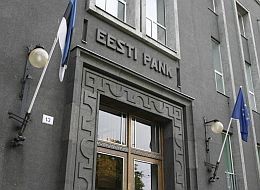Analytics, Economics, Estonia, GDP
International Internet Magazine. Baltic States news & analytics
Friday, 09.05.2025, 12:26
Eesti Pank cuts economic growth forecast for 2012-2014
 Print version
Print version |
|---|
Eesti Pank said in its comments that as the external environment has
worsened, Estonian economic growth has slowed in 2012 to 2.9%.
Uncertainty caused by the euro area debt crisis and expectations of a
slower recovery in the external environment have made the outlook for
2013 and 1014 more pessimistic than the bank suggested in the June
forecast. Next year the Estonian economy is expected to grow by 3.0%,
and in 2014 by 4.0%. In June, the central bank forecast 2.6% economic
growth for this year, 3.6% for 2013 and 4.1% for 2014, writes LETA.
The forecast shows that many of Estonia's economic indicators are close to balance, though that balance could easily be disrupted. For this reason the main goal of Estonian economic policy for the years ahead should be to maintain and build the confidence already shown in the economic environment, the central bank said.
Confidence in the Estonian economy will facilitate investment and create a base for sustainable economic growth. Equally, an overly-rapid expansion of credit caused by low interest rates should be avoided. Care must be taken in the labour market to ensure that wages do not rise too fast, as that will put pressure on prices and damage the competitiveness of the economy. In addition to domestic factors, a resolution of the euro area crisis is important for stable growth and economic activity needs to recover in Estonia's main export destinations.
Extraordinarily low base interest rates throughout the forecast period will encourage borrowing. The high capitalisation levels of the Estonian banking sector and the rapid expansion in deposits provide a strong base for financing businesses and households. Favourable borrowing conditions, a better outlook for growth than in other euro area countries, and sound economic policy together create a favourable environment for businesses to make investments and expand production capacity. However, demand for loans is likely to remain modest, as businesses faced with uncertain conditions look for ways to finance investment from their own resources. Households will also generally remain cautious about taking loans due to the uncertainty. For this reason, the baseline scenario of the forecast predicts that the loan stock will grow more slowly than nominal Gross Domestic Product (GDP) and the ratio of loans to GDP will fall further in the future.
Labour market developments have been favourable in 2012, with employment rising and unemployment falling continuously. The financial circumstances of households will improve in future as wages and employment both continue to grow, though the rate of numbers being added to the ranks of the employed will slow. The shortage of labour has become an increasingly important limiting factor for production, and continuing high structural unemployment may hinder business expansion and slow growth in the future. Labour shortages also run the risk of leading to pressure for wages to rise too fast and to an upsurge in prices. To bring unemployment down further and solve the problems caused by labour shortages, active labour market measures should be effective and risk groups brought into employment.
Inflation in 2012 was 4.3% and expectations for energy and food are significantly higher than in the June forecast. Inflation will fall in the next two years, to 3.6% in 2013 and 2.4% in 2014. If price rises are to slow, it is important that the global oil price fall from its current high levels and that the prices of food commodities fall after their rapid rises in 2012.
The general government fiscal position continues to be stronger than others in the euro area. The budget deficit for 2012 will be around one per cent of GDP, which is less than was forecast in June. The main reason for the difference is that investment costs have been deferred. The general government budget for 2014 will be close to nominal balance. Given the economic circumstances, the budget should have reached balance or surplus by 2013, as was planned in the 2011 state budget strategy. In this, the forecast reflects a certain weakening of budget discipline. For the government to maintain credibility, the target of achieving fiscal balance in 2014 must not be missed.








 «The Baltic Course» Is Sold and Stays in Business!
«The Baltic Course» Is Sold and Stays in Business!

